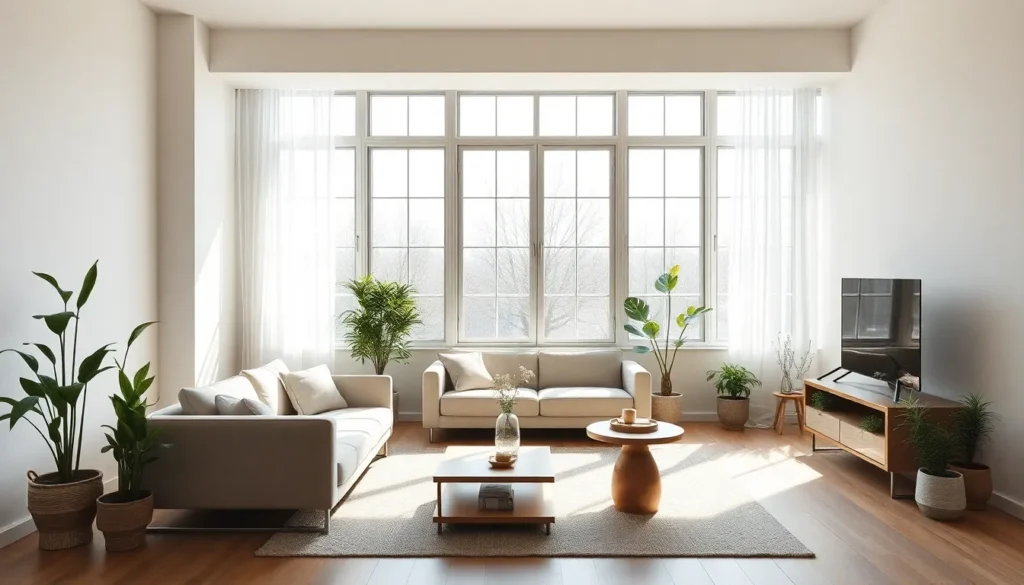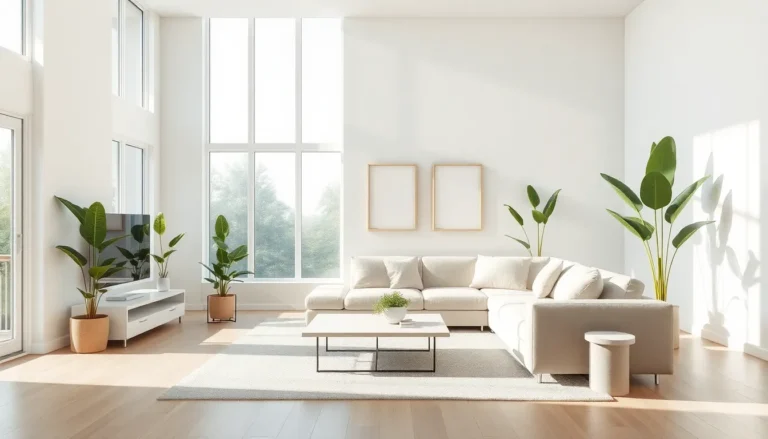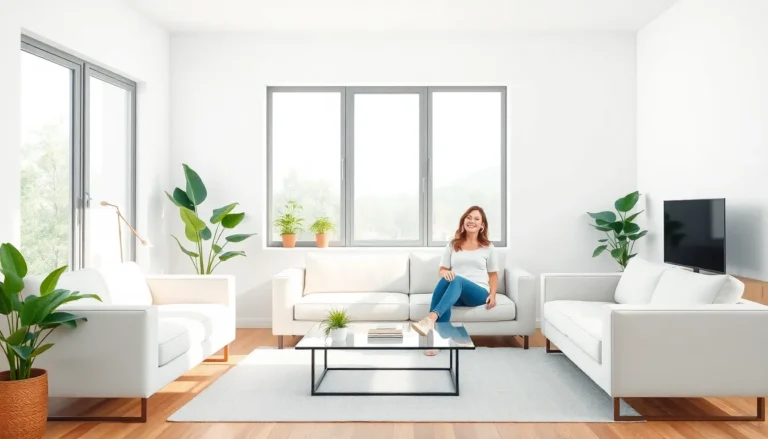Table of Contents
ToggleIn a world overflowing with stuff, the minimalist apartment stands out like a sleek unicorn in a cluttered barnyard. Imagine living in a space that feels airy and calm, where every item has a purpose and a place. It’s not just a trend; it’s a lifestyle choice that makes you question if you really need that collection of novelty mugs. Spoiler alert: you don’t.
Minimalism isn’t about deprivation; it’s about liberation. It’s the art of living with less, allowing you to focus on what truly matters—like binge-watching your favorite shows without tripping over last season’s clothes. With the right approach, a minimalist apartment can transform a chaotic life into a serene sanctuary. Ready to dive into the world of minimalist living? Let’s explore how to create a stylish space that’s as functional as it is fabulous.
What Is a Minimalist Apartment?
A minimalist apartment serves as a living space designed to prioritize simplicity and functionality. This approach emphasizes clean lines, open spaces, and an uncluttered aesthetic, allowing residents to enjoy a calmer environment. Essential features include minimal furniture, few decorative items, and a neutral color palette that enhances brightness and airiness.
In minimalist apartments, each item serves a purpose. Furniture pieces are often multipurpose, such as a sofa bed or a coffee table with storage, maximizing utility without overcrowding the space. The arrangement encourages movement, fostering a sense of freedom and relaxation.
Natural light plays a crucial role in these spaces. Large windows allow sunlight to flood in, creating a warm atmosphere that enhances the feeling of openness. Plants may be incorporated to add a touch of nature, providing both beauty and improved air quality without adding clutter.
Mindfulness is a key component of minimalist design. Residents often select items that resonate personally, avoiding mass-produced décor that doesn’t reflect their style. This selection process helps in cultivating a space that feels inviting and intentional.
Creating a minimalist apartment also involves organization. Storage solutions often consist of hidden compartments, such as under-bed boxes or wall-mounted shelves, keeping the living area organized and functional. This strategic arrangement reduces visual noise, leading to a more peaceful home.
Ultimately, a minimalist apartment offers a sanctuary amid external chaos. It inspires occupants to embrace a lifestyle centered on intentionality and clarity, where every detail contributes to a harmonious living experience.
Benefits of Living in a Minimalist Apartment

Living in a minimalist apartment offers various advantages that contribute to a simpler and more focused lifestyle. These benefits enhance overall well-being and showcase the appeal of minimalist living.
Simplicity and Efficiency
Simplicity defines the essence of minimalist living. A minimalist apartment fosters an environment where fewer possessions create less distraction. Clutter-free spaces encourage clear thinking and enhanced productivity. Efficiency is achieved through multifunctional furniture that serves various needs, maximizing the utility of each piece. Open layouts promote free movement and easy access, reducing the time spent tidying up. Fewer items mean less commitment to maintain, allowing residents to focus on experiences rather than possessions.
Cost-Effectiveness
Cost savings often accompany a minimalist lifestyle. Minimalist apartments typically require fewer furnishings and decorations, leading to lower initial investment costs. Utility bills decrease due to smaller spaces that require less energy for heating or cooling. Additionally, purchasing fewer items results in long-term financial savings. A streamlined lifestyle encourages mindful spending choices, ensuring that purchases align with personal values and needs. Residents can channel financial resources toward meaningful experiences, promoting a richer life without unnecessary expenses.
Key Features of a Minimalist Apartment
A minimalist apartment embodies simplicity and efficiency, creating a serene living environment. Key features include open space design and functional furniture.
Open Space Design
Open space design promotes freedom and airiness within the apartment. Large living areas allow for easy movement and flexibility, enhancing the sense of space. Elements like high ceilings contribute to this feeling by drawing the eye upward. Combining the living room, dining area, and kitchen fosters a seamless flow, making social interactions more enjoyable. Natural light floods the space through large windows, adding warmth and inviting nature indoors. This connection to the outside world reinforces the tranquil atmosphere that minimalist living aims to achieve.
Functional Furniture
Functional furniture serves multiple purposes while maintaining a clean aesthetic. Multi-use items like sofa beds or nesting tables maximize space and help avoid clutter. A focus on quality over quantity ensures durable pieces that enhance the environment. Choosing streamlined designs without heavy ornamentation complements the minimalist ethos. Sleek storage solutions, such as ottomans or cabinets, enable effective organization without sacrificing style. Prioritizing these elements allows residents to curate a space that is both stylish and practical, embodying the essence of minimalist living.
How to Create a Minimalist Apartment
Creating a minimalist apartment involves intentional decisions about space, design, and organization. The following guidelines provide practical steps to achieve a serene and functional living environment.
Decluttering Tips
Start by assessing belongings to determine what truly matters. Separating items into categories—keep, donate, and discard—can simplify the decision-making process. Next, focus on one room at a time to avoid feeling overwhelmed. Utilize storage solutions, like baskets and boxes, to conceal less frequently used items. Consider the “one in, one out” rule; this encourages mindful purchasing habits and prevents accumulation. Regularly reevaluating possessions ensures the space remains uncluttered and aligned with minimalist principles.
Choosing the Right Color Palette
Selecting a soothing color palette sets the foundation for a minimalist apartment. Neutral tones—such as whites, grays, and beiges—create a calm atmosphere and enhance natural light. Accents in soft pastels or earthy shades can add visual interest without overwhelming the senses. Consider incorporating texture through fabrics and materials to maintain depth in the design. Limit bold colors and patterns to a few key pieces, allowing them to stand out in a clean, unified space. By focusing on cohesive color schemes, a minimalist environment feels inviting and tranquil.
Challenges of Minimalist Living
Minimalist living presents challenges that some individuals may find difficult to navigate. Reducing possessions can evoke emotional responses, as people often attach memories to items. Adjusting to a limited lifestyle requires a change in mindset, which may lead to discomfort for those accustomed to abundance.
Transitioning to a minimalist apartment also involves practicality issues. Finding multifunctional furniture that marries style with utility might prove challenging. Moreover, organizing space without visual clutter is essential, requiring intentional choices regarding which items to keep.
Adapting to a minimalist aesthetic can create challenges in personal expression. Individuals often struggle to find balance between minimalism and their design preferences, impacting how much personality they can showcase in their living space. Achieving a cohesive look without sacrificing personal style demands effort and careful selection.
Living minimally may also lead to social pressures. Friends and family might not understand the minimalist philosophy, posing challenges during gatherings where possessions often take center stage. Communicating one’s choices effectively becomes important to bridge understanding and avoid judgment.
Budget constraints could complicate the minimalist lifestyle as well. Quality over quantity remains a fundamental principle, yet premium items come with a higher price tag. Individuals may face difficulties in allocating resources to invest in durable, multifunctional furniture that aligns with minimalist principles.
Commitment is required for maintaining a minimalist lifestyle long-term. Regularly evaluating possessions and making conscious decisions about acquisitions can become tedious. Staying steadfast in minimalism necessitates discipline, contributing to the ongoing challenge of this lifestyle.
Embracing a minimalist apartment can lead to a transformative living experience. By prioritizing simplicity and functionality, individuals can cultivate an environment that fosters clarity and tranquility. The journey toward minimalism encourages mindful choices and intentional living, allowing residents to focus on what truly matters.
While challenges may arise in the transition to a minimalist lifestyle, the benefits far outweigh the difficulties. A well-designed minimalist space not only enhances productivity but also promotes a sense of peace. With dedication and thoughtful planning, anyone can create a stylish and serene sanctuary that reflects their personal values and aspirations.








